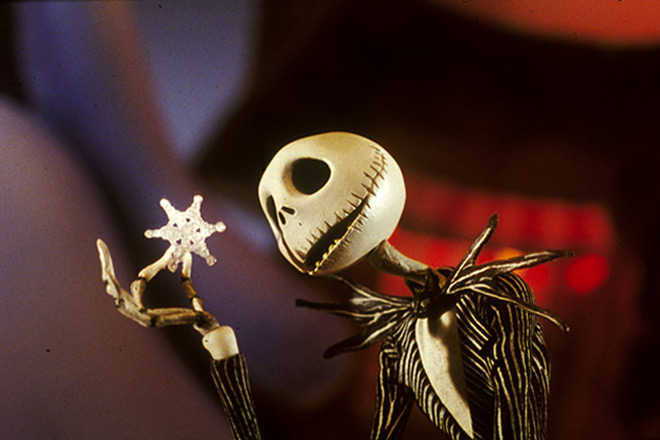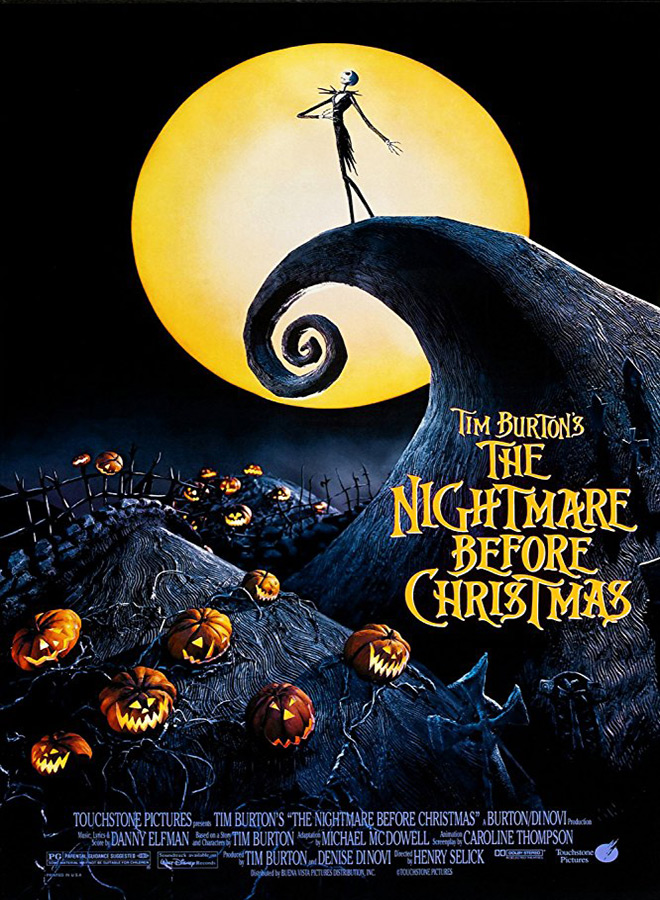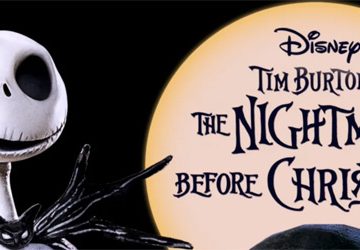It was 25 years ago that the Pumpkin King of Halloween Town first proclaimed, “This is Halloween!” On Friday, October 29, 1993, Tim Burton’s stop-motion musical The Nightmare Before Christmas arrived in theaters and would quickly grow to become a holiday-bending cult classic.

“Boys and girls of every age, wouldn’t you like to see something strange?” The gloriously classic, macabre musical The Nightmare Before Christmas delivered exactly what it promised! With a cast of wonderfully bizarre characters – from Jack Skellington (Chris Sarandon/Danny Elfman), the Pumpkin King, to his love interest Sally (Catherine O’Hara) – the film introduced its viewers to a whole new world, to Halloween Town and its myriad of inhabitants. There is the naughty threesome of Lock (Paul Reubens), Shock (O’Hara), and Barrel (Elfman); that rotten Oogie Boogie (Ken Page); Skellington’s beloved pooch, Zero; Sally’s keeper, Dr. Finklestein (William Hickey); the Mayor of Halloween Town (Glenn Shadix); and, lest he not be forgotten, the man with the bag, Santa Claus (Ed Ivory).
Burton has noted that his inspirations for The Nightmare Before Christmas were myriad, from the holiday overlap of merchandise in stores to Rankin/Bass Christmas specials (Rudolph the Red-Nosed Reindeer 1964, Santa Claus Is Comin’ to Town 1970), to the artistic works of Ronald Searle and Edward Gorey. In fact, it’s reported that, at one point in time, Burton heavily considered The Nightmare Before Christmas as being a TV special and not a feature film.
Alas, before we get ahead of ourselves, there is one very important question dancing throughout the core of The Nightmare Before Christmas: Is this even a Tim Burton film? While the story was written by Burton, from characters of his own invention and based on a three-page poem he had authored in the ‘80s, the film itself was actually directed by Henry Selick (James and the Giant Peach 1996, Coraline 2009). Burton was a producer on the project, yes, as well as a writer, but he did not direct the film. There is, of course, as with all great film offerings, controversy. Selick says he spent more time on set and in production than Burton – who was busy directing 1993’s Batman Returns and in pre-production for 1994’s Ed Wood – though Burton maintains that the film is centered around his work and creations. In the press, Selick has made the analogy that Burton laid the egg, and he is the one who incubated that egg and sat on it until it hatched. So, which came first: the Burton or the Selick?

Whatever the case, viewers ended up with a brilliant film wrought in the tradition of Burton’s eclectic, whimsical style. As any diehard fan knows, this attention to minute detail carries over into the film, where there are hidden references throughout – from hidden Mickeys and a set of Donald Duck pajamas to nods to Burton’s Ed Wood biopic as well as 1988’s Beetlejuice, and beyond. In fact, Burton himself, as well as Patrick Stewart, were each supposed to have cameos in the film. While Stewart’s monologue managed to make it onto the film’s soundtrack, Burton was simply cut from the film altogether – though his visage lives on in old, cut footage archives. Of course, these are not the only Easter eggs embedded in The Nightmare Before Christmas, and multiple viewings of the film are required to find all the hidden gems.
Creating such a complicated and extravagant production was no easy feat, and it took a group of over 100 people to utilize 20 different sound stages, which took nearly three years to complete. For one second of film, up to 12 stop-motion moves had to be made; in total, there were something like 109,440 frames taken. There were 227 puppets that brought the characters to life, and Jack himself reportedly had over 400 heads. To help ease the transition of all of these moving parts, the set reportedly contained secret passageways for the animators that included trapdoors. The bottom line is that this was a complicated endeavor, and it took a small army to bring The Nightmare Before Christmas to life!
Clearly, they succeeded admirably at their work! The film has grossed upwards of $76 million and has been re-released in multiple formats (including 3D) since its original debut. Therefore, it’s no shock that The Nightmare Before Christmas met with accolades, including nominations for Best Visual Effects at the Academy Awards along with the Hugo Award for Best Dramatic Presentation. It actually won the Saturn Award for Best Fantasy Film, while Danny Elfman’s phenomenal score won Best Music.

Furthermore, Elfman’s genius score would go on to become a classic in the pantheon of animated musicals. You know the songs: from “What’s This?” to “Kidnap The Sandy Claws,” “This Is Halloween” to “Jack’s Lament.” As beloved as the film itself, a special reissue of the soundtrack arrived in 2006, featuring a bonus disc with covers from the likes of Fall Out Boy, Panic! at the Disco, Marilyn Manson, Fiona Apple, and She Wants Revenge. In 2008, Disney released the cover collection Nightmare Revisited, which featured another eclectic line-up that featured Amy Lee of Evanescence, Flyleaf, Korn, Rise Against, Plain White T’s, The All-American Rejects, and more.
So, with so much love for The Nightmare Before Christmas, a sequel is a given, right? Well, no, not really! In 2001, Walt Disney Pictures toyed with the idea of producing a sequel, one that would not use stop-motion but instead computer animation/CGI. A staunch advocate for authenticity and protecting the uniqueness of his films, Burton fought against this idea. Despite there being no plans for a sequel anytime soon, The Nightmare Before Christmas and its wonderfully iconic characters continue to crop up in other locations, notably the video game series Kingdom Hearts and, of course, at Disney theme parks.

Love it or hate it (but how could you?), The Nightmare Before Christmas holds a zillion distinctions – perhaps the least of which is being the sole stop motion-animated film to earn a PG rating from the MPAA. It’s a ‘little’ film that came from seemingly nowhere to change the face of entertainment in 1993 and for many, many years beyond. In fact, its influence is still detectable in popular culture some twenty-five years later and shows no signs of slowing. There’s no denying the creative genius behind the film or the delicious infectiousness of its phenomenal score, and for that, you cannot help but love Jack Skellington, Sally, Zero, Oogie Boogie, and all their wonderfully bizarre cohorts. So, boys and girls of every age, let us celebrate something strange!






No comment